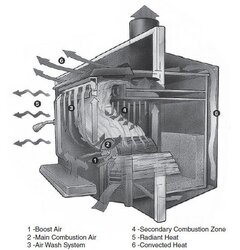Hi all,
Getting my Lopi Republic 1750 installed in a few weeks and I have a few questions to help guide my installation.
I have a brick chimney that's built off the side of the house (so an external chimney) on a part of the house that's single-story angled roof. The hearth is raised ~1 foot + the fireplace height + the need to go above roofline means my liner run is going to be ~16 feet.
I was told that they'll install a block-off plate on the top of the chimney where the liner exits. Is there any benefit to having a block-off plate installed at the bottom, where the wood burning stove meets the liner + chimney entrance? Is that even an option?
I'm going to get an insulated liner to help protect the longevity of the brick and help me keep a good draft. Plus it should only be like $150 extra considering the short run of the liner. Any particular types of insulation I should request or guidance there?
Should a good installer automatically re-do the mortar crown as part of the job? Mine may need it.
Is there different options for chimney caps that make it easier for future self-maintenance, or are they all pretty much the same?
Thanks all,
Joe
Getting my Lopi Republic 1750 installed in a few weeks and I have a few questions to help guide my installation.
I have a brick chimney that's built off the side of the house (so an external chimney) on a part of the house that's single-story angled roof. The hearth is raised ~1 foot + the fireplace height + the need to go above roofline means my liner run is going to be ~16 feet.
I was told that they'll install a block-off plate on the top of the chimney where the liner exits. Is there any benefit to having a block-off plate installed at the bottom, where the wood burning stove meets the liner + chimney entrance? Is that even an option?
I'm going to get an insulated liner to help protect the longevity of the brick and help me keep a good draft. Plus it should only be like $150 extra considering the short run of the liner. Any particular types of insulation I should request or guidance there?
Should a good installer automatically re-do the mortar crown as part of the job? Mine may need it.
Is there different options for chimney caps that make it easier for future self-maintenance, or are they all pretty much the same?
Thanks all,
Joe


